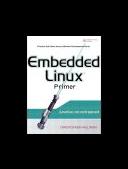Книга: Embedded Linux Primer: A Practical, Real-World Approach
6.1.3. Minimal File System
6.1.3. Minimal File System
To illustrate the requirements of the root file system, we have created a minimal root file system. This example was produced on the ADI Engineering Coyote Reference board using an XScale processor. Listing 6-1 is the output from the TRee command on this minimal root file system.
Listing 6-1. Contents of Minimal Root File System
.
|-- bin
|
| |-- busybox
|
| '-- sh -> busybox
|-- dev
|
| '-- console
|-- etc
|
| '-- init.d
|
| '-- rcS
'-- lib
|-- ld-2.3.2.so
|-- ld-linux.so.2 -> ld-2.3.2.so
|-- libc-2.3.2.so
'-- libc.so.6 -> libc-2.3.2.so
5 directories, 8 files
This root configuration makes use of busybox, a popular and aptly named toolkit for embedded systems. In short, busybox is a stand-alone binary that provides support for many common Linux command line utilities. busybox is so pertinent for embedded systems that we devote Chapter 11, "BusyBox," to this flexible utility.
Notice in our example minimum file system in Listing 6-1 that there are only eight files in five directories. This tiny root file system boots and provides the user with a fully functional command prompt on the serial console. Any commands that have been enabled in busybox[48] are available to the user.
Starting from /bin, we have the busybox executable and a soft link called sh pointing back to busybox. You will see shortly why this is necessary. The file in /dev is a device node[49] required to open a console device for input and output. Although it is not strictly necessary, the rcS file in the /etc/init.d directory is the default initialization script processed by busybox on startup. Including rcS silences the warning message issued by busybox if rcS is missing.
The final directory entry and set of files required are the two libraries, GLIBC (libc-2.3.2.so) and the Linux dynamic loader (ld-2.3.2.so). GLIBC contains the standard C library functions, such as printf() and many others that most application programs depend on. The Linux dynamic loader is responsible for loading the binary executable into memory and performing the dynamic linking required by the application's reference to shared library functions. Two additional soft links are included, ld-linux.so.2 pointing back to ld-2.3.2.so and libc.so.6 referencing libc-2.3.2.so. These links provide version immunity and backward compatibility for the libraries themselves, and are found on all Linux systems.
This simple root file system produces a fully functional system. On the ARM/XScale board on which this was tested, the size of this small root file system was about 1.7MB. It is interesting to note that more than 80 percent of that size is contained within the C library itself. If you need to reduce its size for your embedded system, you might want to investigate the Library Optimizer Tool at http://libraryopt.sourceforge.net/.
- 6.1. Root File System
- 8.1.3. Minimal Device Driver Example
- Shared Cache file
- Безопасность внешних таблиц. Параметр EXTERNAL FILE DIRECTORY
- Chapter 13. rc.firewall file
- System tools used for debugging
- Integrated Secure Communications System
- 4.3.3. Makefile Targets
- Что это за файл – pagefile.sys?
- Для чего нужны папки Windows, Documents and Settings, Program Files и Temp?
- Когда включаю компьютер, при загрузке пишется Insert system disk and press enter. Что нужно делать?
- Можно ли указать использование по умолчанию вместо C:Program Files другого каталога для установки программ?




